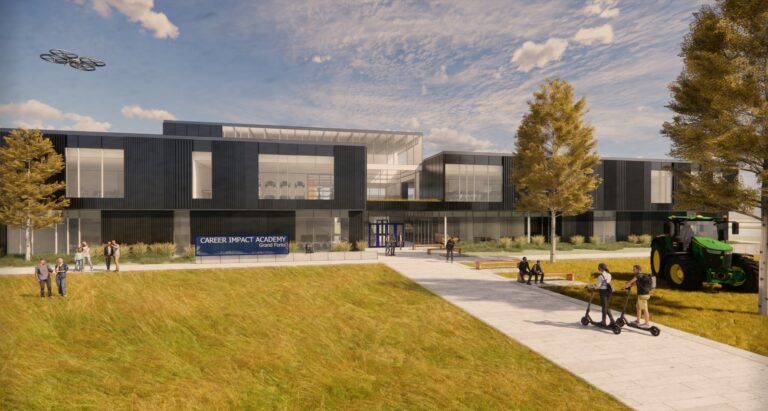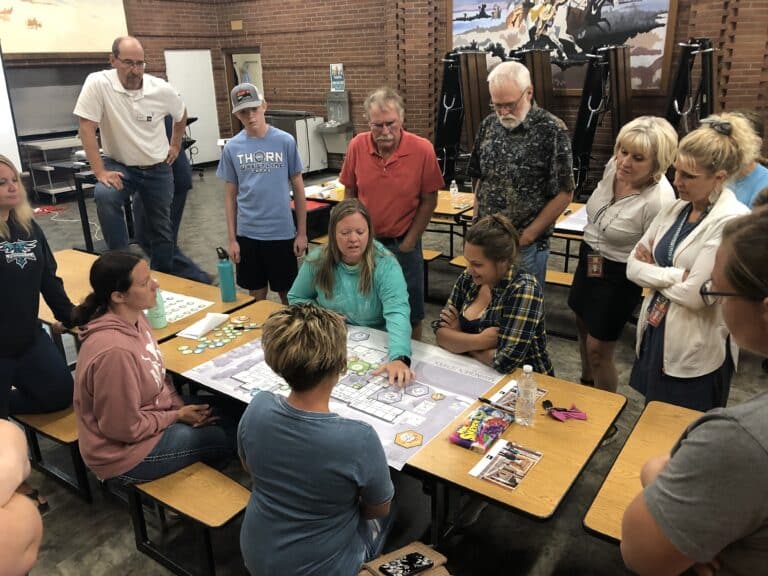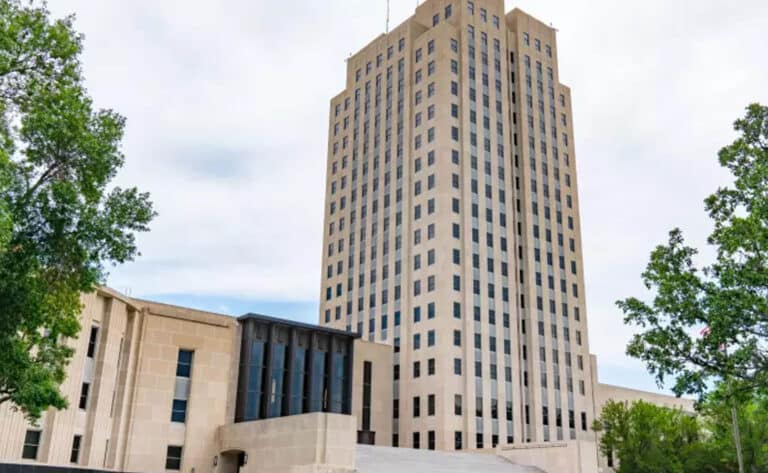Up and down the Red River Valley, school boards are facing the challenges of maintaining and upgrading aging buildings and the inner workings-mechanical, electrical, plumbing, heating-which makes them habitable.
They’re grappling with questions such as, how much should they invest in these structures? What are the consequences of delaying investment? And, at what point is it smarter and more economical, in the long run, to build new?
Because schools rely so heavily on state funding, the questions are even more critical in light of decreased state revenues due to downturns in the agriculture and oil industries.
In Grand Forks, the School Board is taking a long view, looking five, 10, 15 years down the road at what will most benefit future students. JLG Architects of Grand Forks was hired in February to conduct a thorough assessment of its buildings. The firm’s findings will help the board make decisions about budgeting and long-range planning.
“Our goal is to come up with an implementable plan,” Ted Rozeboom, K-12 planning and programming specialist with JLG, said at a recent School Board facilities committee meeting to review progress on the assessment. “Tell us what is affordable.”
One problem the School Board faces can be summed up in the adage, “perception is reality.”
“People drive by a building and think it looks fine. They don’t see anything wrong with it, yet the ‘guts’ of it has issues,” said Michael McLean, of JLG Architects, who’s heading up the facilities assessment project.
“If you don’t do anything else, you do have to invest in your buildings,” Rozeboom said.
Problems with heating, ventilation and air conditioning, or HVAC, systems and roofing plague older structures and can impact learning, for example, in classrooms that are too hot or too cold, or where noisy pipes break concentration or air quality is compromised.
“Mechanical, electrical and plumbing (costs) are a huge part of this,” Rozeboom said. “More than half the schools have major issues.”
About three-quarters of the $74 million in deferred maintenance the district needs to address involve upgrading of this type of equipment, he said.
“Quite a few buildings in the district don’t have sprinkler systems,” said McLean. “That’s a life safety issue.”
Bringing buildings up to safety and accessibility codes is a major consideration, he said.
Although the term “deferred maintenance” is commonly used in crafting a budget, the facilities assessment team, board members and district personnel agreed that it is misleading.
“It makes people think that things are not being done that should have been done,” or that someone hasn’t been taking care of equipment or property, said Superintendent Larry Nybladh. “That is not true.”
The equipment that runs the building is usually unseen and underappreciated, until something goes wrong.
“With electrical and plumbing (systems), people take for granted that things are going to just come on,” said Chris Arnold, director of buildings and grounds for Grand Forks Public Schools, as he checked out the mechanical room recently at Winship Elementary School.
“But it wears out,” he said. “Every mechanical device will functionally wear out.”
When the outdated hot-water boiler heating system at Winship broke down beyond repair in April, a complete replacement was needed. The system that failed was original to the school, built in 1974.
Installing the new system, which features current technology and 14 gas-fired units, cost $520,000, according to Ed Gerhardt, the school district’ business manager.
Mechanical equipment in the district’s older schools—West, Lewis and Clark, Viking and Wilder elementary and Valley and Twining middle schools—should be upgraded in the next five to seven years, McLean said.
Regional challenges
Grand Forks is not alone in dealing with these issues. School superintendents and their boards around the region are facing, or have dealt with, similar challenges.
Last summer, after finding evidence of spot leaking in the roof at Central Valley Public School in Buxton, N.D., the school board voted to replace a large section at a cost of $104,000.
Another sizeable section will be replaced next spring, said Superintendent Jeremy Brandt, and
three other, smaller sections also will be replaced.
The total investment in the school’s roof will climb to more than $250,000.
The roof of Central Valley school, constructed in 1964, “was past its time of usefulness,” Brandt said. In general, “roofs are definitely a significant investment.”
On Tuesday, voters in the New Rockford-Sheyenne (N.D.) School District passed a bond issue, with more than 60 percent approval, that allows the district to secure a 2 percent loan for $3.25 million from The Bank of North Dakota to update its facilities.
Funds will be spent to improve ventilation and insulation, replace deteriorated windows, and deal with moisture, mold and air quality problems, Superintendent Jill Louters said.
On Dec. 12, voters in the Hatton Eielson School District in Hatton, N.D., will be asked to approve a measure that paves the way for construction of a $6.3 million addition to the school. One part of the school was built in 1908 and another in 1934, and an addition was constructed in 1995, said Superintendent Kevin Rogers.
“We stick a lot of maintenance into those older buildings, and it drains the building fund,” said Rogers. “We’ve been up against all those issues—safety, accessibility, mechanical, electrical, the whole HVAC system.”
‘Huge investment’
Grand Forks “has a huge investment” in its buildings, Rozeboom told the School Board’s facilities committee Monday.
The school district’s 19 buildings are insured for $283 million, an amount which reflects the “best estimate” of the replacement cost per square foot, said Gerhardt. The age of the buildings is not a factor in this estimate.
Even those buildings that were updated after the 1997 flood need close inspection, said Jeremiah Johnson, a mechanical engineer with Obermiller Nelson Engineering of Fargo.
“A lot of issues were addressed to get the schools (reopened) after the flood, but the life expectancy of air-handling equipment (for example) is 20 to 30 years,” Johnson said. “We’re getting to that 20-year mark.”
School buildings have “a good shell, good bones,” he said, “but the equipment itself doesn’t last as long as the building.”
The facilities assessment team presented several options at Monday’s meeting.
Scenarios for change include consolidation of selected elementary schools, converting Valley Middle School to an elementary school, building a new middle or elementary school, expanding the Career and Technical Education facilities at Red River High School, and relocating the child nutrition facility.
“This is like a menu, you can pick and choose which pieces you want,” Rozeboom said. “In a good master plan, you eliminate those moves that could be undone (later).”
The material “doesn’t have a time frame,” Rozeboom said. “Even it you don’t do something this year, that doesn’t mean you shouldn’t have a plan.”
School Board President Doug Carpenter said it’s up to the School Board to determine “what is in the realm of possible,” and then share its conclusions with the community.
When the board does arrive at decisions about the future of its school buildings, the board needs “to provide the rationale for why we’re thinking what we’re thinking,” Carpenter said.
He hopes the final report concerning facilities, which will be presented as part of a public forum in January, “will generate discussion, not controversy.”
“A lot depends on the next legislative session,” Carpenter said. “Because the vast majority of our funding comes from the state, we’re feeling the pain the rest of the state feels too.”
‘Must haves’
Since Arnold took over as the district’s director of buildings and grounds Sept. 22, he has visited “13 or 14 schools,” he said. “Each building has its own list.”
His goal is “to find out what are the ‘must haves,’ ” he said. “Is it air conditioning at Central? Is it getting the heating and cooling fixed at Ben Franklin? Is it replacing the carpeting at Phoenix that’s getting kind of ratty-looking?”
The district’s school buildings are safe, he emphasized, but when they reach “60 to 70 years old, it’s time to take a strong look: Do you invest in this?”
“It’s my job to guide our ship, to ensure that our taxpayers’ dollars are invested fairly,” Arnold said. “I hope we can put our money where it’s most effective and most needed.”





